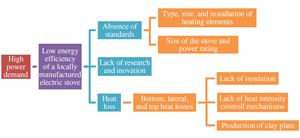Porous Maize Stalk Cellulose Fiber-Reinforced Geopolymer Composites for Heat Insulation at the Bottom Side of a Local Electric Stove
DOI:
https://doi.org/10.46604/peti.2022.8589Keywords:
geopolymer, kaolin, insulation, composites, organic oilAbstract
The objective of this work is to develop porous maize stalk cellulose fiber-reinforced geopolymer composites for heat insulation on the bottom side of an electric stove using the solid impregnation method. Heat loss measurement is conducted using an infrared thermometer. Moreover, the temperature effect on the composites is investigated. The maize stalk cellulose fibers are very essential to anticipate the cracking phenomenon generated by high temperatures. The degradation of the fibers causes the formation of small cavities in the matrix, and thus leads to high temperatures. The experimental result shows that it takes 22 minutes to boil water using the proposed electric stove, whereas it takes 29 minutes using the existing local electric stove. By using the proposed electric stove to boil water, 113,793,148.104 KWh of energy per year at the national level can be saved.
References
J. Fen, et al., “Development of Porous Fly Ash-Based Geopolymer with Low Thermal Conductivity,” Materials and Design, vol. 65, pp. 529-533, January 2015.
H. H. Murray, “Traditional and New Applications for Kaolin, Smectite, and Palygorskite: A General Overview,” Applied Clay Science, vol. 17, no. 5-6, pp. 207-221, November 2000.
H. H. Murray, “Overview—Clay Mineral Applications,” Applied Clay Science, vol. 5, no. 5-6, pp. 379-395, March 1991.
W. E. Worrall, “Clays: Their Nature, Origin and General Properties”, 1st ed., London: Maclaren and Sons, 1968.
V. Srivastava, “Clays: Types and Applications,” Bulletin of the Catalysis Society of India, vol. 11, no. 5, pp. 56-77, 2012.
G. Brindley, et al., “The Kaolinite-Mullite Reaction Series: II, Metakaolin,” Journal of the American Ceramic Society, vol. 42, no. 7, pp. 314-318, July 1959.
V. M. Malhotra, et al., “Pozzolanic and Cementitious Materials,” 1st ed., Amsterdam: Gordon and Breach, 1996.
B. B. Sabir, et al., “Metakaolin and Calcined Clays as Pozzolans for Concrete: A Review,” Cement and Concrete Composites, vol. 23, no. 6, pp. 441-454, December 2001.
B. Singh, et al., “Geopolymer Concrete: A Review of Some Recent Developments,” Construction and Building Materials, vol. 85, pp. 78-90, June 2015.
S. H. Sanni, et al., “Performance of Alkaline Solutions on Grades of Geopolymer Concrete,” International Journal of Research in Engineering and Technology, vol. 2, no. 11, pp. 366-371, November 2013.
W. D. Rickard, et al., “Performance of Solid and Cellular Structured Fly Ash Geopolymers Exposed to a Simulated Fire,” Cement and Concrete Composites, vol. 48, pp. 75-82, April 2014.
T. Bakharev, “Resistance of Geopolymer Materials to Acid Attack,” Cement and Concrete Research, vol. 35, no. 4, pp. 658-670, April 2005.
P. Palmero, et al., “Geopolymer Technology for Application-Oriented Dense and Lighted Materials, Elaboration and Characterization,” Ceramics International, vol. 41, no. 10, pp. 12967-12979, December 2015.
C. Bai, “High-Porosity Geopolymer Foams with Tailored Porosity for Thermal Insulation and Waste Water Treatment,” Journal of Materials Research, vol. 32, no. 17, pp. 3251-3259, September 2017.
Z. Zhang, et al., “Geopolymer Foam Concrete: An Emerging Material for Sustainable Construction,” Construction and Building Materials, vol. 56, pp. 113-127, February 2014.
C. Bai, G. Franchin, H. Elsayed, A. Conte, and P. Colombo, “High Strength Metakaolin-Based Geopolymer Foams with Variable Macroporous Structures,” Journal of the European Ceramic Society, vol. 36, no. 16, pp. 4243-4249, December 2016.
M. Łach, et al., “Determination of the Influence of Hydraulic Additives on the Foaming Process and Stability of the Produced Geopolymer Foams,” Materials, vol. 14, no. 17, Article no. 5090, September 2021.
M. Łach, “Geopolymer Foams—Will They Ever Become a Viable Alternative to Popular Insulation Materials? —A Critical Opinion,” Materials, vol. 14, no. 13, Article no. 3568, July 2021.
S. K. Kaliappan, et al., “Effect of Pore-Forming Agents on Geopolymer Porosity and Mechanical Properties,” 3rd International Conference on Applied Science Technology, pp. 1-7, September 2018.
C. Bai, et al., “Low-Temperature Fabrication of SiC/Geopolymer Cellular Composites,” Composites Part B: Engineering, vol. 137, pp. 23-30, March 2018.
P. Hua, et al., “Adsorption of Acid Green and Procion Red on a Magnetic Geopolymer Based Adsorbent: Experiments, Characterization, and Theoretical Treatment,” Chemical Engineering Journal, vol. 383, Article no. 123113, March 2020.
M. S. Cilla, et al., “Geopolymer Foams Obtained by the Saponification /Peroxide/Gelcasting Combined Route Using Different Soap Foam Precursors,” Journal of the American Ceramic Society, vol. 100, no. 8, pp. 3440-3450, August 2017.
J. Fiset, et al., “Macroporous Geopolymer Designed for Facile Polymers Post-Infusion,” Ceramic and Concrete Composite, vol. 110, Article no. 103591, July 2020.
M. S. Cilla, et al., “Effect of Process Parameters on the Physical Properties of Porous Geopolymers Obtained by Gelcasting,” Ceramics International, vol. 40, no. 8, pp. 13585-13590, September 2014.
C. Shi, et al., “Recent Progress in Low-Carbon Binders,” Cement and Concrete Research, vol. 122, pp. 227-250, August 2019.
M. H. Kebede, et al., “Home Appliance Efficiency Improvements for Energy Conservation in Debre Berhan City: Ethiopia,” American Journal of Energy Engineering, vol. 6, no. 2, pp. 10-14, July 2018.
“Project Document on Locally Manufactured Electric Stoves: Energy Efficiency Standards and Labeling,” http://196.188.108.86/images/Resources/Directorate/Energyefficiency&conservation/1-6%20Final%20project%20document%20Locally%20manufactured%20electric%20stoves%20April%2019%202017.pdf, 2017.
A. Workiye, et al., “Development of Maize Stalk Cellulose Fiber Reinforced Calcined Kaolin Clay Geopolymer Composite,” Proceedings of Engineering and Technology Innovation, vol. 16, pp. 30-38, August 2020.
“Design of Prototype of Locally Manufactured Electric Stoves,” http://196.188.108.86/media/attachments/EEA%20PUBLICAIONS/Energy%20related%20publications/21%20Locally%20manufactured%20electric%20stove%20Design%20of%20prototype%20and%20list%20of%20required%20materials.pdf, 2019.

Published
How to Cite
Issue
Section
License
Submission of a manuscript implies: that the work described has not been published before that it is not under consideration for publication elsewhere; that if and when the manuscript is accepted for publication. Authors can retain copyright of their article with no restrictions. Also, author can post the final, peer-reviewed manuscript version (postprint) to any repository or website.

Since Oct. 01, 2015, PETI will publish new articles with Creative Commons Attribution Non-Commercial License, under The Creative Commons Attribution Non-Commercial 4.0 International (CC BY-NC 4.0) License.
The Creative Commons Attribution Non-Commercial (CC-BY-NC) License permits use, distribution and reproduction in any medium, provided the original work is properly cited and is not used for commercial purposes







